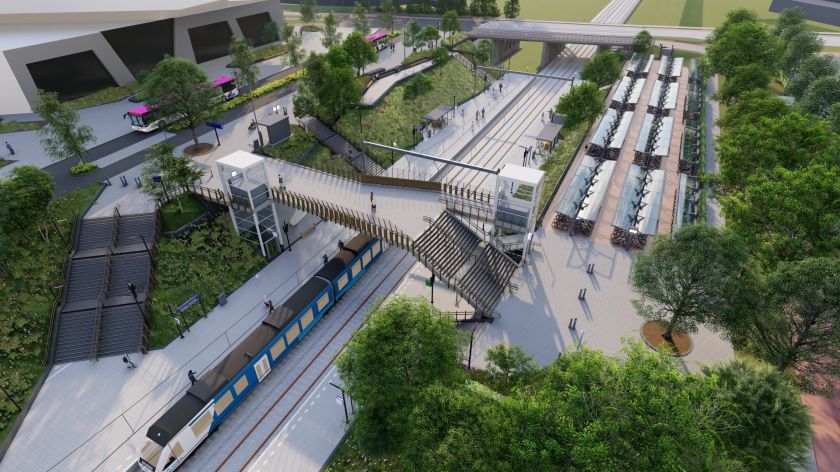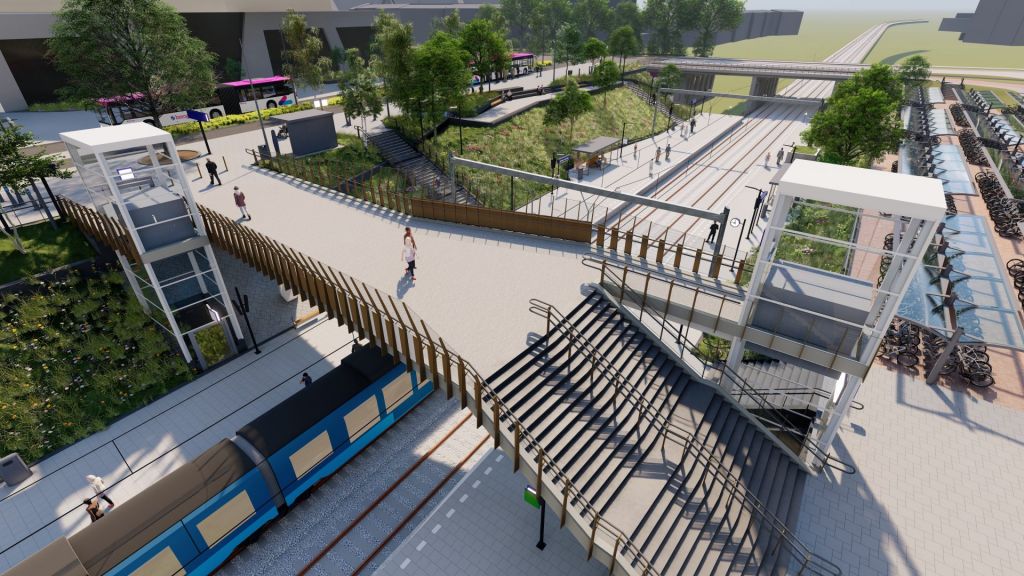Metamorphosis Heyendaal station starts: wider stairs and safer crossing
-
 Artist impression of Heyendaal station. Photo: Municipality of Nijmegen
Artist impression of Heyendaal station. Photo: Municipality of Nijmegen
The renovation of Heyendaal station has started last week. The station will get wider platforms and stairs, a new walkway across the railway, and a bigger bike stall. The renovation should be finished in early 2025. Five questions regarding the renovation.
#1 What made the redesign necessary?
Heyendaal station has grown significantly since its construction in 1972: About 14.500 commuters make use of the train station every day now. This makes the station one of the busiest in the area. Rail operator ProRail expects the number of commuters to increase even more the next ten years. The whole thing has to be kicked up a notch in order for transit to run smoothly.
Moreover, the station also has an outdated look, according to the Nijmegen municipality. It apparently does not fit with the modern campus area anymore.
The renovation is part of the larger plans to make the campus area more accessible while keeping sustainability intact. Other ideas of the collaboration Duurzaam Bereikbaar Heijendaal, which is working out the accessibility and sustainability, are making part of the Heyendaalseweg and Erasmuslaan car-free and focusing on shared mobility.
#2 What is changing?
The station is undergoing a big metamorphosis. For instance, there will be wider platforms and more and wider stairs on both sides of the railway. Additionally, the platforms will contain more indoor waiting areas. The walkway is also going to be renewed: the new walkway is wider and more accessible through the north of the station, on the side of the Technovium. Furthermore, there will be 120 new bike stalls.
The surrounding area will also be redesigned. For instance, there will be more seats on the north side and there will be more greenery. At the railway side of the Verlengde Groenestraat, there will be an additional pavement, allowing students on their way to the HAN to not have to walk across the street during rush hours.
#3 It was once suggested to create an entrance to the platforms on the other side of the Heyendaalseweg, what about that?
The junction of the Heyendaalseweg and the Verlengde Groenestraat has been a subject of debate for years. Many cyclists and walkers come together over there, who sometimes have to cross the Heyendaalseweg in between cars. This regularly causes dangerous situations, especially during rush hours.
In order to realise a safer walking route, the university previously suggested creating an entrance to the station on the east side of the Heyendaalseweg. Students and employees on their way to Mercator 1 of the Huygens building could then walk under the Heyendaalseweg.

In reality, this did not seem feasible, a spokesperson of the Nijmegen municipality states. ‘The idea was logical, but the flyover is too low and we thought it would be socially unsafe.’ The spokesperson states that should the flyover ever be built, the idea could still stand a chance.
A crossing point will be constructed in the middle of the Heyendaalseweg, which means that the street does not have to be crossed in one go, to make walking and cycling routes to and from the Huygens building a little bit safer. These will be placed just beside the Verlengde Groenestraat.
#4 When is the construction finished and how much hindrance can be expected?
The bike stalls are temporarily moved to the Kiss and Ride of the station this week. The renovation will begin next week.
The renovation should have been finished by the end of the year, but the end date is postponed to early 2025. At a later stage, the Maaslijn will also be renewed (see question 5).
Trains will not be able to run across the railway at certain times, for instance when the new walkway will be placed. Four weekends have been confirmed so far during which no trains will run. The first train-free weekend is that of June 1. The data can be found online.
#5 So what about the electrification of the Maaslijn?
The construction of the Maaslijn will start soon as well, after several years of delay. The rail connection between Nijmegen and Roermond will get an electric overhead line in 2025 – and there will be more double-track railways, as can be read on the website of ProRail. After the adjustments, more trains will be able to run the route and the current, short local train will be replaced by the longer electric version. The renovations are expected to be finished by 2027.
Translated by Juan Paas



